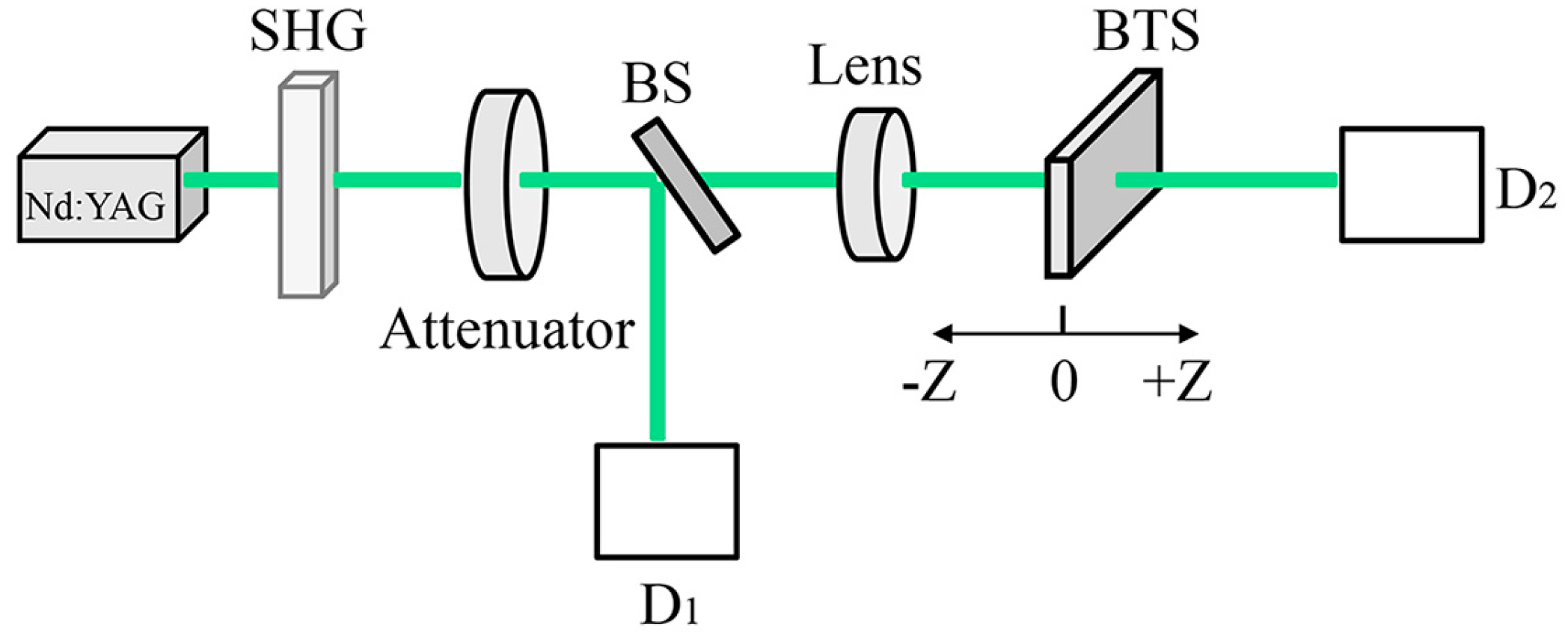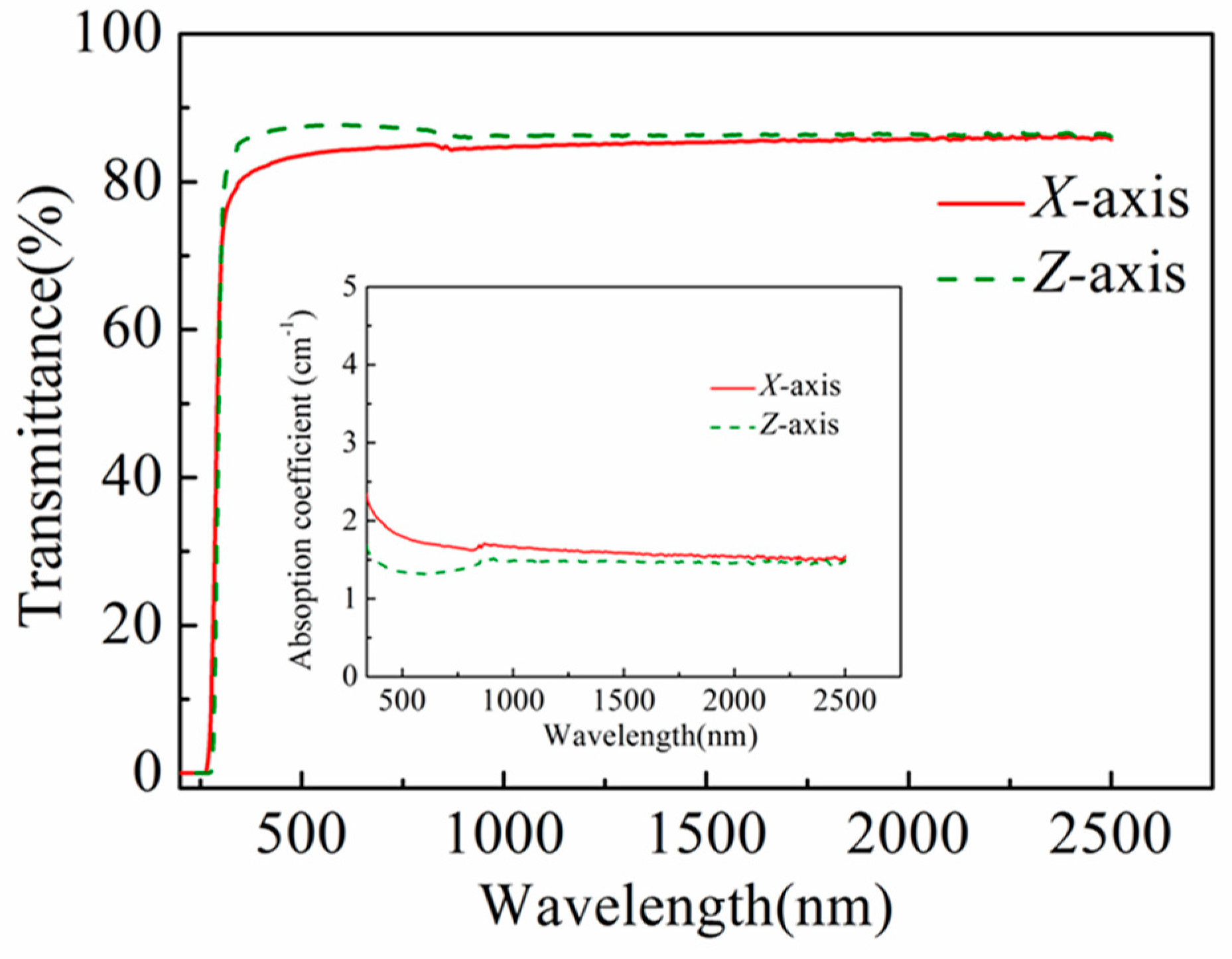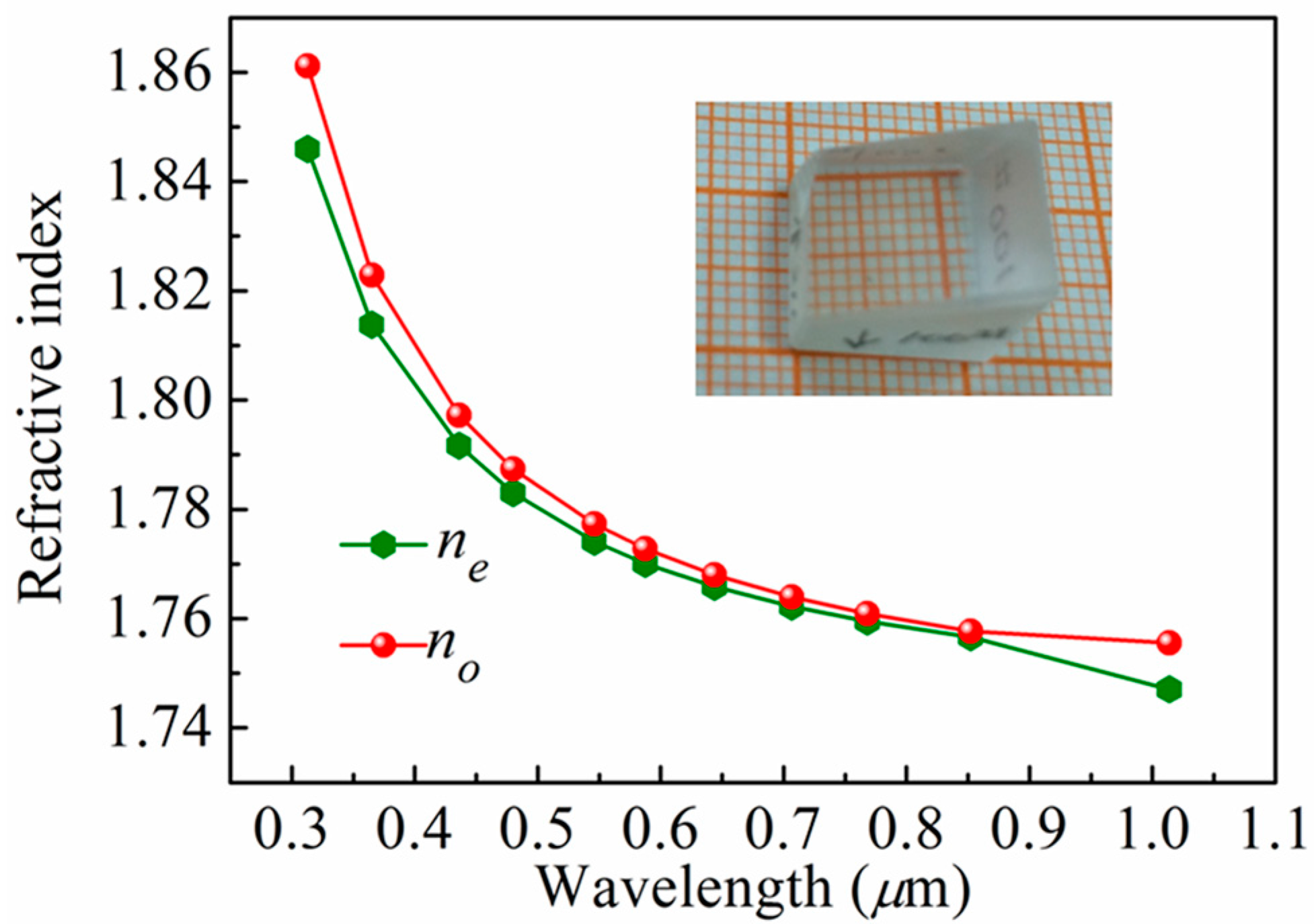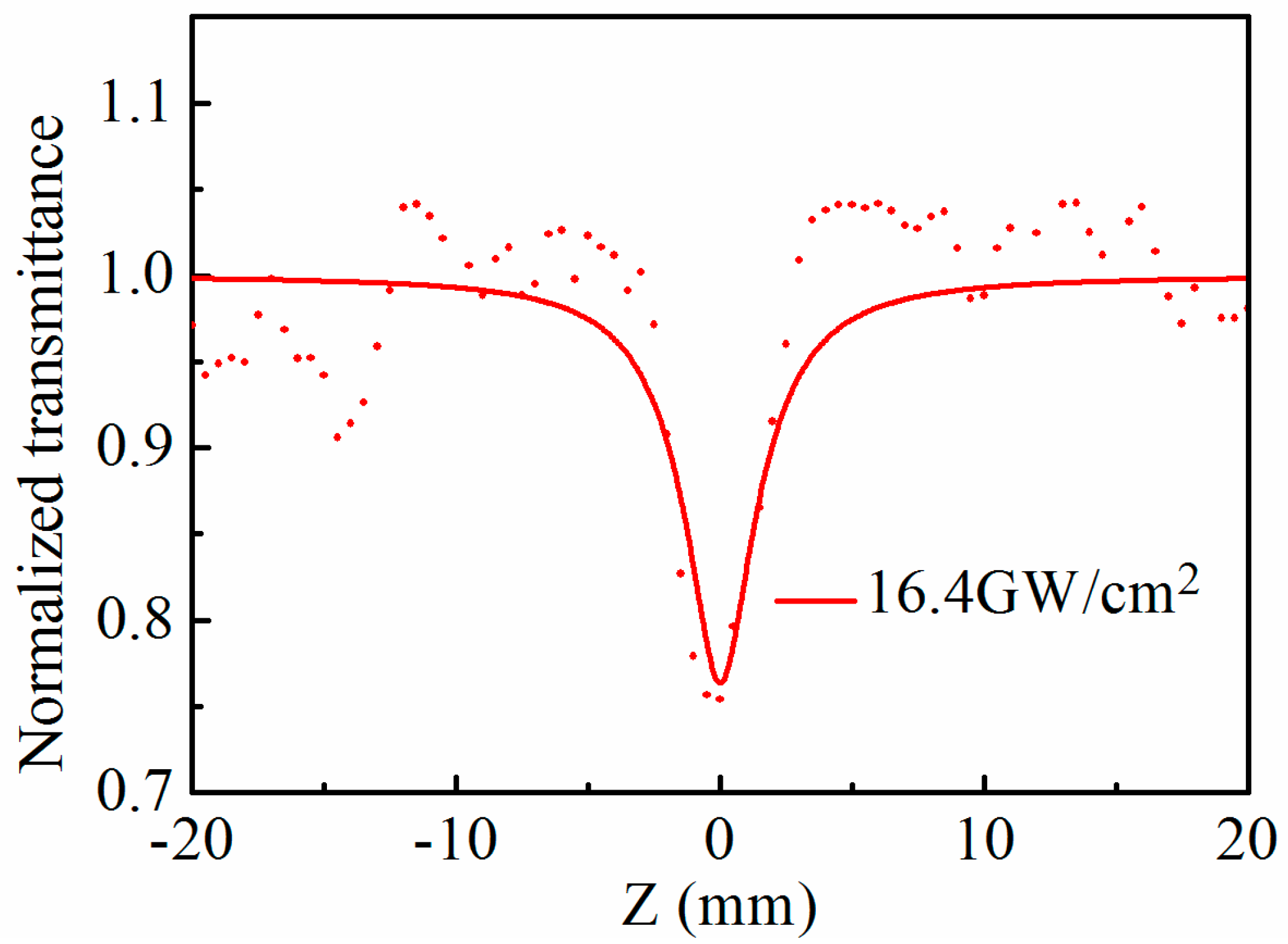Optical Properties of the Fresnoite Ba2TiSi2O8 Single Crystal
Abstract
:1. Introduction
2. Experimental Details
3. Results and Discussion
3.1. Transmission Spectrum
3.2. Refractive Index
3.3. Z-Scan Performance
4. Conclusions
Acknowledgments
Author Contributions
Conflicts of Interest
References
- Moore, P.B.; Louisnathan, S.J. Fresnoite: Unusal Titanium Coordination. Science 1967, 156, 1361–1362. [Google Scholar] [CrossRef] [PubMed]
- Masai, H.; Tsuji, S.; Fujiwara, T.; Benino, Y.; Komatsu, T. Structure and non-linear optical properties of BaO-TiO2-SiO2 glass containing Ba2TiSi2O8 crystal. J. Non-Cryst. Solids 2007, 353, 2258–2262. [Google Scholar] [CrossRef]
- Kimura, M.; Fujino, Y.; Kawamura, T. New piezoelectric crystal: Synthetic fresnoite (Ba2Si2TiO8). Appl. Phys. Lett. 1976, 29, 227–228. [Google Scholar] [CrossRef]
- Shen, C.-Y.; Zhang, H.-J.; Cong, H.-J.; Yu, H.-H.; Wang, J.-Y.; Zhang, S.-J. Investigations on the thermal and piezoelectric properties of fresnoite Ba2TiSi2O8 single crystals. J. Appl. Phys. 2014, 116, 044106. [Google Scholar] [CrossRef]
- Halliyal, A.; Bhalla, A.S.; Cross, L.E. Phase transitions, dielectric, piezoelectric and pyroelectric properties of barium titanium germanate Ba2TiGe2O8 single crystals. Ferroelectrics 1985, 62, 3–9. [Google Scholar] [CrossRef]
- Kimura, M.; Utsumi, K.; Nanamatsu, S. Ferroelastic behavior in Ba2Ge2TiO8. J. Appl. Phys. 1976, 47, 2249–2251. [Google Scholar] [CrossRef]
- Markgraf, S.A.; Bhalla, A.S. Low-temperature phase transition in Ba2TiGe2O8. Phase Transit. 1989, 18, 55–76. [Google Scholar] [CrossRef]
- Schmid, H.; Genequand, P.; Tippmann, H.; Pouilly, G.; Guedu, H. Pyroelectricity and related properties in the fresnoite pseudobinary system Ba2TiGe2O8-Ba2TiSi2O8. J. Mater. Sci. 1978, 13, 2257–2265. [Google Scholar] [CrossRef]
- Takahashi, Y.; Benino, Y.; Fujiwara, T.; Komatsua, T. Large second-order optical nonlinearities of fresnoite-type crystals in transparent surface-crystallized glasses. J. Appl. Phys. 2004, 95, 3503–3508. [Google Scholar] [CrossRef]
- Haussühl, S.; Eckstein, J.; Recker, K.; Wallrafen, F. Growth and physical properties of fresnoite Ba2TiSi2O8. J. Cryst. Growth 1977, 40, 200–204. [Google Scholar] [CrossRef]
- Yu, X.-Y.; Wang, H.-Y.; Rong, X.-W. Origin of the giant quadratic electro-optic effect in KTa1-xNbxO3 single crystals. Opt. Mater. 2015, 46, 429–431. [Google Scholar] [CrossRef]
- Chang, Y.-C.; Wang, C.; Yin, S.-Z.; Hoffman, R.C.; Mott, A.G. Giant electro-optic effect in nanodisordered KTN crystals. Opt. Lett. 2013, 38, 4574–4577. [Google Scholar] [CrossRef] [PubMed]
- Delre, E.; Mei, F.D.; Parravicini, J.; Parravicini, G.; Agranat, A.J.; Conti, C. Subwavelength anti-diffracting beams propagating over more than 1000 Rayleigh lengths. Nat. Photonics 2015, 9, 228–232. [Google Scholar]
- Tian, H.; Yao, B.; Zhou, Z.X.; Wang, H.F. Voltage-controlled diffraction modulation in manganese-doped potassium sodium tantalate niobate single crystals. Appl. Phys. Express 2012, 5, 012602. [Google Scholar] [CrossRef]
- Shen, C.-Y.; Wang, D.-L.; Zhang, H.-J.; Wang, J.-Y.; Boughton, R.-I. Fresnoite Ba2TiSi2O8—A novel stimulated Raman scattering active crystal. Appl. Phys. Express 2016, 9, 122402. [Google Scholar] [CrossRef]
- Tian, H.; Zhou, Z.; Gong, D.; Wang, H.; Liu, D.; Jiang, Y. Growth and optical properties of paraelectric K1−yNayTa1−xNbxO3 single crystals. Appl. Phys. B 2008, 91, 75–78. [Google Scholar] [CrossRef]
- Tian, H.; Hu, C.P.; Meng, X.D.; Tan, P.; Zhou, Z.X.; Li, J.; Yang, B. Top-Seeded Solution Growth and Properties of K1-xNaxNbO3 Crystals. Cryst. Growth Des. 2015, 15, 1180–1185. [Google Scholar] [CrossRef]
- Wang, X.-P.; Li, Q.-G.; Yang, Y.-G.; Zhang, Y.-Y.; Lv, X.-S.; Wei, L.; Liu, B.; Xu, J.-H.; Ma, L.; Wang, J.-Y. Optical, dielectric and ferroelectric properties of KTa0.63Nb0.37O3 and Cu doped KTa0.63Nb0.37O3 single crystals. J. Mater. Sci. Mater. Electron. 2016, 27, 13075–13079. [Google Scholar] [CrossRef]
- Wisniewski, W.; Nagel, M.; Rüssel, C. Macroscopic, Glass-Permeated Single-Crystals of Fresnoite. CrystEngComm 2015, 17, 5019–5025. [Google Scholar] [CrossRef]
- Robbins, C.R. Synthesis and growth of fresnoite (Ba2TiSi2O8) from a TiO2 flux and its relation to the system BaTiO3-SiO2. J. Res. Natl. Bur. Stand. A Phys. Chem. 1969, 74, 229–232. [Google Scholar] [CrossRef]
- Bechthold, P.S.; Haussühl, S.; Michael, E.; Eckstein, J.; Recker, K.; Wallrafen, F. Second Harmonic Generation in Fresnoite, Ba2TiSi2O8. Phys. Lett. 1978, 65A, 453–454. [Google Scholar] [CrossRef]
- Shen, C.-Y.; Zhang, H.-J.; Cong, H.-J.; Yu, H.-H.; Wang, J.-Y.; Zhang, S.-J. Voltage-controlled diffraction modulation in manganese-doped potassium sodium tantalate niobate single crystals. J. Appl. Phys. 2014, 116, 044106. [Google Scholar] [CrossRef]
- Seema, R.; Sandeep, C.S.S.; Philip, R.; Kalarikkal, N. An open aperture Z-scan study of Sr2CeO4 blue phosphor. J. Alloys Compd. 2011, 509, 8573–8576. [Google Scholar] [CrossRef]
- Sheik-Bahae, M.; Said, A.A.; Wei, T.-H.; Hagan, D.J.; Van Stryland, E.W. Sensitive measurement of optical nonlinearities using a sinlge beam. IEEE J. Quantum Electron. 1990, 26, 760–769. [Google Scholar] [CrossRef]
- Wei, R.F.; Tian, X.L.; Zhang, H.; Hu, Z.L.; He, X.; Chen, Z.; Chen, Q.Q.; Qiu, J.R. Facile synthesis of two-dimensional WS2 with reverse saturable absorption and nonlinear refraction properties in the PMMA matrix. J. Alloys Compd. 2016, 684, 224–229. [Google Scholar] [CrossRef]
- Hong, L.Y. The Investigations of the Third Order Nonlinear Optical Properties and Response Time of DMIT Type Materials. Doctoral Dissertation of Shandong University, Jinan, Shandong Province, China, 2006. [Google Scholar]
- Zhao, G.; Zhang, F.; Wu, Y.Z.; Hao, X.P.; Wang, Z.P.; Xu, X.G. One-Step Exfoliation and Hydroxylation of Boron Nitride Nanosheets with Enhanced Optical Limiting Performance. Adv. Opt. Mater. 2016, 4, 141–146. [Google Scholar] [CrossRef]
- Maslov, V.A.; Mikhailov, V.A.; Shaunin, O.P.; Shcherbakov, I.A. Nonlinear absorption in KTP crystals. Quantum Elect. 1997, 27, 356–359. [Google Scholar] [CrossRef]
- Badorreck, H.; Nolte, S.; Freytag, F.; Baune, P.; Dieckmann, V.; Imlau, M. Scanning nonlinear absorption in lithium niobate over the time regime of small polaron formation. Opt. Mater. Express 2015, 5, 2729–2741. [Google Scholar] [CrossRef]
- Anis, M.; Muley, G.G.; Hakeem, A.; Shirsat, M.D.; Hussaini, S.S. Exploring the influence of carboxylic acids on nonlinear optical (NLO) and dielectric properties of KDP crystal for applications of NLO facilitated photonic devices. Opt. Mater. 2015, 46, 517–521. [Google Scholar] [CrossRef]
- Zhong, J.S.; Zhao, H.J.; Zhang, C.L.; Ma, X.; Pei, L.; Liang, X.J.; Xiang, W.D. Sol–gel synthesis and optical properties of CuGaS2 quantum dots embedded in sodium borosilicate glass. J. Alloys Compd. 2014, 610, 392–398. [Google Scholar] [CrossRef]
- Zhang, C.L.; Xiang, W.D.; Luo, H.Y.; Liu, H.T.; Liang, X.J.; Ma, X.; Pei, L.; Chen, Z.P.; Li, J.S.; Gao, H.H.; Ma, L. Third-order optical nonlinearity of Na2O-B2O3-SiO2 glass doped with lead nanoparticles prepared by sol–gel method. J. Alloys Compd. 2014, 602, 221–227. [Google Scholar] [CrossRef]
- Fan, H.L.; Wang, X.Q.; Ren, Q.; Li, T.B. Third-order nonlinear optical properties in [(C4H9)4N]2[Cu (C3S5)2]-doped PMMA thin film using Z-scan technique in picosecond pulse. Appl. Phys. A 2010, 99, 279–284. [Google Scholar] [CrossRef]
- Wang, D.L.; Li, T.B.; Wang, S.L.; Wang, J.Y.; Wang, Z.P.; Ding, J.X.; Li, W.D.; Shen, C.Y.; Liu, G.X.; Huang, P.P. Effect of Fe3+ on third-order optical nonlinearity of KDP single crystals. CrystEngComm 2016, 18, 9292–9298. [Google Scholar] [CrossRef]




| Wavelength (μm) | no | ne | Δn |
|---|---|---|---|
| 0.31256 | 1.86109 | 1.84596 | 0.01513 |
| 0.36502 | 1.82291 | 1.81381 | 0.00910 |
| 0.43584 | 1.79722 | 1.79166 | 0.00556 |
| 0.47999 | 1.78742 | 1.78304 | 0.00438 |
| 0.54608 | 1.78304 | 1.77736 | 0.00568 |
| 0.58756 | 1.77281 | 1.77008 | 0.00273 |
| 0.64385 | 1.76803 | 1.76582 | 0.00221 |
| 0.70652 | 1.76399 | 1.76223 | 0.00176 |
| 0.76819 | 1.76091 | 1.75949 | 0.00142 |
| 0.85211 | 1.75767 | 1.75664 | 0.00103 |
| 1.01398 | 1.75553 | 1.7430248 | 0.01251 |
| A | B | C | D | |
|---|---|---|---|---|
| no | 3.0492 ± 0.0045 | 0.0294 ± 0.0010 | 0.0266 ± 0.0018 | −0.013 ± 0.0045 |
| ne | 3.1024 ± 0.0119 | 0.0183 ± 0.0023 | 0.0393 ± 0.0057 | 0.0734 ± 0.0128 |
| Peak Power Density (GW/cm2) | Nonlinear Optical Parameters | |
|---|---|---|
| β (cm/GW) | (10−13esu) | |
| 16.4 | 0.257 ± 0.019 | 5.46 ± 0.4 |
© 2017 by the authors. Licensee MDPI, Basel, Switzerland. This article is an open access article distributed under the terms and conditions of the Creative Commons Attribution (CC BY) license ( http://creativecommons.org/licenses/by/4.0/).
Share and Cite
Shen, C.; Zhang, H.; Wang, D.; Wang, J.; Boughton, R.I. Optical Properties of the Fresnoite Ba2TiSi2O8 Single Crystal. Crystals 2017, 7, 53. https://doi.org/10.3390/cryst7020053
Shen C, Zhang H, Wang D, Wang J, Boughton RI. Optical Properties of the Fresnoite Ba2TiSi2O8 Single Crystal. Crystals. 2017; 7(2):53. https://doi.org/10.3390/cryst7020053
Chicago/Turabian StyleShen, Chuanying, Huaijin Zhang, Duanliang Wang, Jiyang Wang, and Robert I. Boughton. 2017. "Optical Properties of the Fresnoite Ba2TiSi2O8 Single Crystal" Crystals 7, no. 2: 53. https://doi.org/10.3390/cryst7020053





